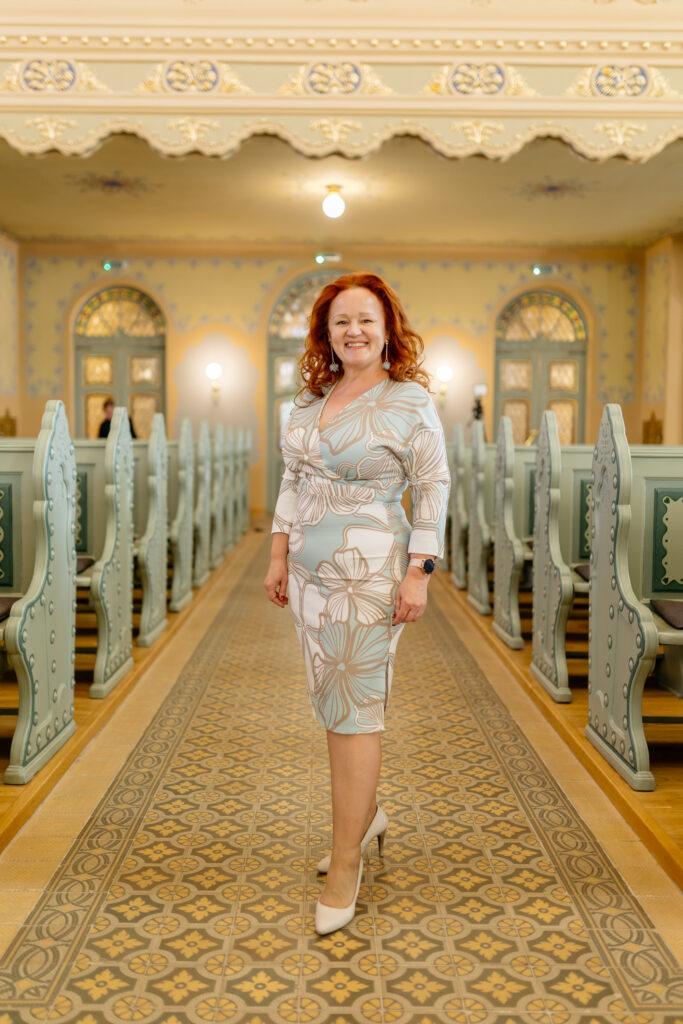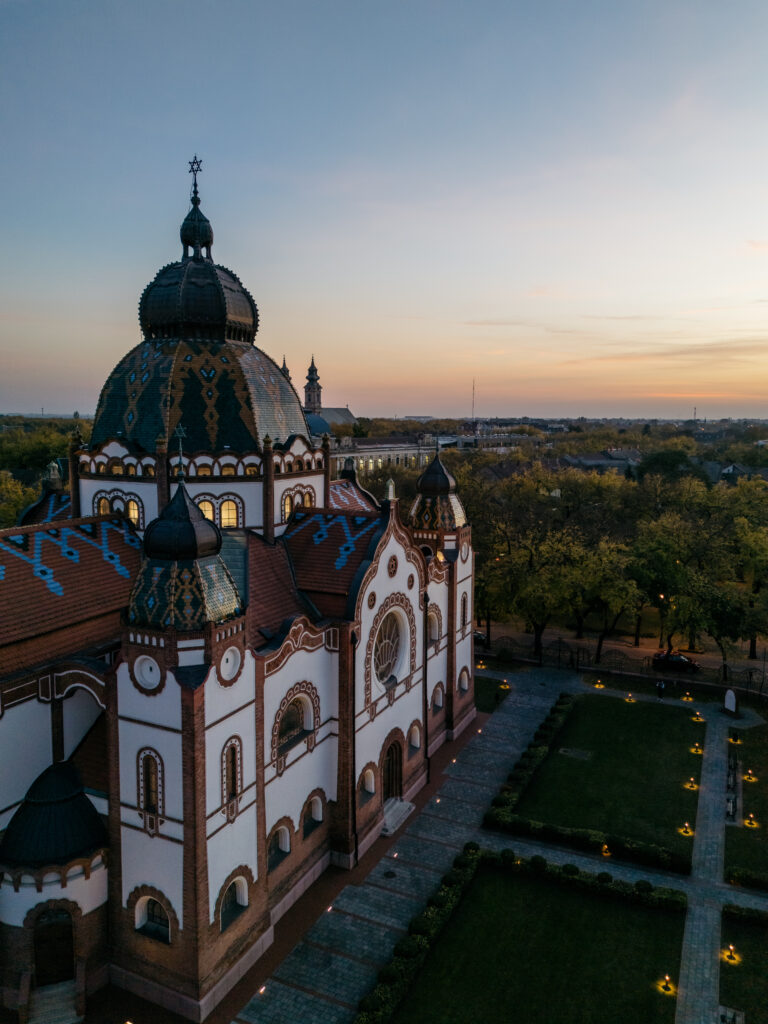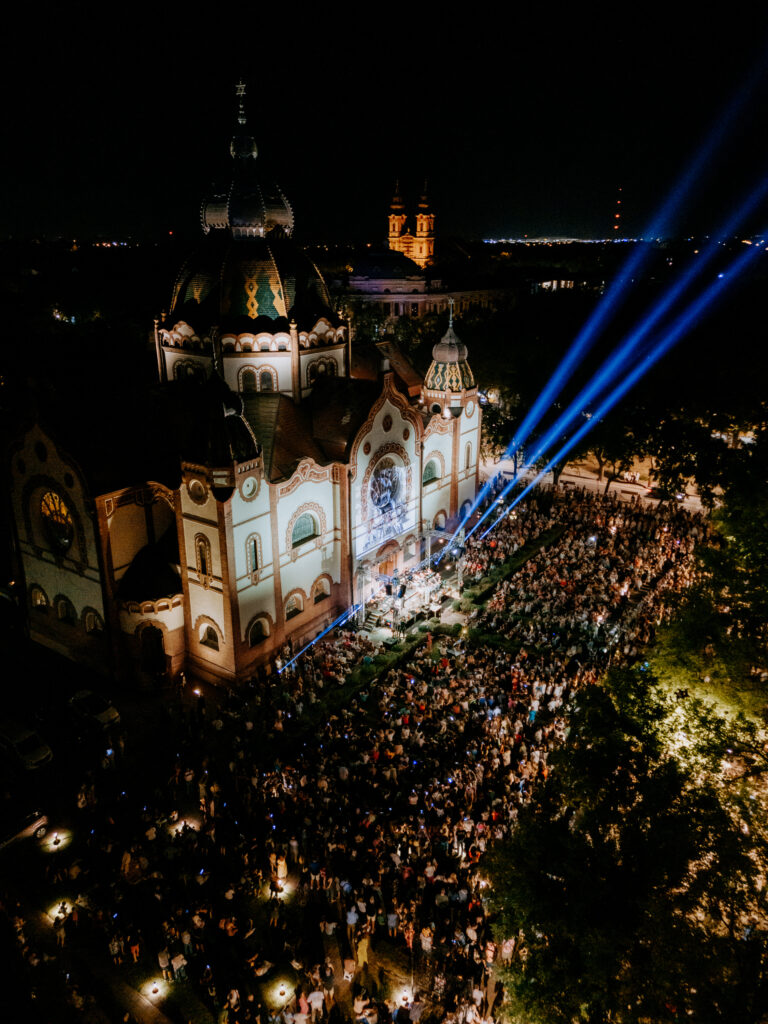The Subotica Synagogue grows into a vibrant cultural hub while preserving its sacred soul
 With deep reverence and a clear vision for the future, Illés Hajnalka, Coordinator of the Subotica Synagogue Foundation, speaks about preserving one of Europe’s most stunning Art Nouveau landmarks — not only as a monument of faith and history, but as a living cultural space for all.
With deep reverence and a clear vision for the future, Illés Hajnalka, Coordinator of the Subotica Synagogue Foundation, speaks about preserving one of Europe’s most stunning Art Nouveau landmarks — not only as a monument of faith and history, but as a living cultural space for all.
The Subotica Synagogue is considered one of the most beautiful examples of Art Nouveau architecture in this part of Europe. How would you describe its significance today – not only as a piece of architecture, but also as a symbol of the community?
The Subotica Synagogue truly is one of the most precious jewels of our city. That may sound like a bit of a cliché or something old-fashioned, but I increasingly believe we are beginning to perceive it that way – just as the exceptionally strong Jewish community must have seen it when they built it in 1902.
When we opened the doors of the restored Subotica Synagogue, I had a great deal to learn and read about the history of the building and the Jewish community of Subotica. I am still learning to this day, but one of the most beautiful things I came across was the account of the day when the newly built synagogue was ceremonially opened. According to old records, there was a procession on foot from the old City Hall to the synagogue, with the city leadership of the time, the heads of the Jewish community, and the then social elite of Subotica. A large crowd of citizens gathered at the synagogue to welcome them, and they all sang Psalm 84 together: “How lovely are your dwellings, O Lord!”
I often imagine that day – the emotional charge, the joy, all those people. I admit, that scene often plays in my mind when our concert audience arrives, or when groups of tourists come. You can see the joy on people’s faces when they enter – first they fall silent, and then I hear them say how unbelievably beautiful the synagogue is. The same goes for our concertgoers – you can see it on their faces. But more on that later…
So, it really is not just a great architectural achievement – although that, in itself, is a significant fact: it is the second largest synagogue in Europe, the only one built in the Hungarian variant of the Art Nouveau style, and it has remained intact. I may be repeating myself, and I know the broader public is aware that the Government of Hungary invested more than 3 million euros in the restoration of this building – but I continue to repeat it, tirelessly. Because why shouldn’t we be grateful, and remain grateful, when thanks to this restoration, our city gained a revitalised Art Nouveau marvel that we can proudly show to the world?
We are the ones who must enter this space – a space of timeless splendour – with deep respect, humility, and gratitude
What are the most important programmes currently run by the Foundation, and how do you manage to connect cultural heritage with contemporary content and the needs of today’s audiences?
This year, we’ve already had the Barcelona Gipsy Balkan Orchestra concert, a performance by Virtuozi, and we’re currently working on the programme for Museum Night, with Art Nouveau Night also approaching. But I would particularly highlight the concert by Croatian singer-songwriter Zlatan Stipišić Gibonni, who will perform at the synagogue on 29 and 31 May. This event is of great importance to us, as Gibonni is not only a renowned artist, but I believe his appearance will greatly contribute to promoting the synagogue.
The “Subotica Synagogue” Foundation operates based on an annual programme. We have two types of events: regular events organised by the Foundation itself, and those hosted by other legal entities upon approval from the Foundation’s Board of Directors.
Our regular events include concerts for Museum Night in the synagogue park; for World Art Nouveau Day, we hold two separate events – Art Nouveau Night and Organ Night (the Wegenstein organ has also been restored!); a concert for Subotica City Day, held on the last Thursday of August, also in the park; and the New Year’s concert. Each year, we also organise a public school lesson to mark International Holocaust Remembrance Day on 27 January, and in October, during Children’s Week, we offer educational content for younger audiences. The other concerts are held by external organisers who are granted permission by the Foundation’s Board.
Planning the annual programme is particularly interesting, as we must consider religious and national holidays, respond to the expectations of our audience, and remain mindful of the sacred nature of the venue itself. One of my most important responsibilities is ensuring that the programme I propose for Board approval upholds the dignity of the synagogue as a space, while also allowing its fantastic acoustics to be enjoyed to the fullest.

You work at the intersection of various identities – religious, cultural, local, and European. How does the Subotica Synagogue contribute to dialogue and understanding between communities?
Our Foundation is governed by a Board of Directors, chaired by the President of the City Assembly. The Board members include representatives of the founding bodies – the building is owned by the City – as well as members of the Jewish community (which is only natural, given that this is their sacred home), and representatives of the Hungarian National Council, which played a key role in coordinating the entire restoration process. This, in itself, is a beautiful reflection of our city’s identity.
In Subotica, everyone – truly everyone – refers to this as “our” synagogue, regardless of their religious or ethnic background. We all feel it belongs to us. That is why, personally, it is extremely important to me that our programmes are open to everyone, and that our concerts are urban in character – because only then can they truly be engaging and inclusive.
The synagogue is not just a building. It is emotion, memory, and community
How challenging is it to preserve the authenticity of such a monument while also making it accessible, vibrant and functional?
It is by no means easy, but we do our best to preserve this treasure in every sense of the word. We are in constant contact with the Intermunicipal Institute for the Protection of Cultural Monuments, as well as with various institutions that were important partners at different stages – during the restoration or at the beginning of its active use.
For me, it is a great source of pride that whenever a problem arises and I seek help or cooperation, the synagogue is always treated as a priority, no matter the time of day. Just like at home, something can always happen, and I am truly grateful that no one ever says, “Alright, we’ll get to it,” only for it to be delayed for days. No – in this case, everyone responds immediately. There is no room for complacency here.
Who are the people who come to the synagogue today – are they driven by curiosity, respect for Jewish culture, or are they searching for something deeper?
The people who come here are, first and foremost, in love with Art Nouveau. The Hungarian variant of this style is so rich, vibrant, and joyful! I should point out that the building is used in three ways. Primarily, it is a sacred space – the Jewish Community of the city uses it for religious services during major Jewish holidays. Secondly, the synagogue serves as a tourist destination. In the first year alone, we had more than 20,000 visitors, and last year over 35,000. We’ve welcomed visitors from every continent. One thing I’m especially proud of is that we offer a digital exhibition and audio guides in seven languages – one of them being Hebrew – and large groups often arrive with their own guides or are accompanied by local tour guides.
And finally – my favourite aspect – we also use the synagogue as a concert venue. The building’s acoustics are magical and, in my opinion, unmatched by any other concert space in the city. Not only due to its capacity (948 seats across the ground floor and gallery, plus 150 additional chairs on the ground floor), but because of the atmosphere itself. It’s as if the walls have preserved the prayers and songs of the Jewish people who built it, and as if the Art Nouveau motifs convey a special sense of elegance and exclusivity. It’s difficult to describe – it has to be experienced. (And I would like to take this opportunity to encourage your readers to follow us on social media and visit our website to stay updated about our concert announcements. Subotica is just around the corner!)

What does the Foundation’s day-to-day work look like – how much of it is management, and how much is a mission filled with emotional and ethical meaning?
Since January 2019, we’ve been operating with regular working hours. We’re open every weekday from 10 a.m. to 6 p.m., except on Mondays, and on weekends from 10 a.m. to 2 p.m. Mondays are reserved for maintenance work on the building and the park. These are the public-facing facts, but behind all of it lies the work of a small yet dedicated team, supported by a network of people who help us – from maintaining the park and replacing worn-out lightbulbs to carpentry, metalwork, and sound support for concerts.
Three young people work at the synagogue’s info desk, handling ticket sales. We have one person responsible for cleaning and another for security. If I had to describe my own responsibilities as coordinator, I would say – first and foremost – that this is a 24-hour role. Of course, it shouldn’t be that way, but that’s how I experience it. I simply don’t know how to work without emotion, and I don’t want to work without a sense of ethical responsibility.
It is a great honour for me to carry out this role, which is much more than just a job. I often reflect on how grateful I am to God for not answering my prayers earlier, when I was younger. This kind of work truly requires age, maturity, and life experience. As we grow older, we gain more compassion and empathy. I am fully aware of where I am and I try to approach both the space and every event held here with deep respect. Someone comes here to pray. That is the foundation, for me.
I don’t know how to work without emotion, and I don’t want to work without a sense of ethical responsibility
Is there a particular event, exhibition or moment in the Foundation’s work that is especially dear to you, one that you would highlight as an example of its purpose?
There have been so many beautiful and meaningful successes, moments when I was truly on the verge of tears – and I don’t hide it, I’ve often had tears of joy after well-organised concerts. It’s incredibly important to me not only to do the job, but to enjoy it as well! I’ve had so many wonderful visits – delegations, school groups, tourists – and countless memorable encounters.
When it comes to concerts, I must highlight last year’s City Day concert, Film Music in the Park, performed by the Novi Sad Big Band with soloist Mattia Zanatta. There were nearly 3,000 joyful people gathered in the synagogue park! Just imagine – all those beautiful melodies we all know and love, regardless of our surnames or beliefs. It was magical! Above us, the Subotica sky and the synagogue’s beautifully lit façade, the colours of the stained glass windows shimmering around us… It truly felt like we were all in a fairy tale. I will never forget that evening.
What would you like the Subotica Synagogue to become in the years ahead – for Subotica, and for the wider region?
My greatest wish is to preserve this magnificent building with the care of a good host, so that we can pass it on to the generations that come after us in the same condition in which we received it. I also sincerely hope that we continue on this path of steady growth. That we don’t give everything all at once, only to find we have nothing new to offer later. Step by step, slowly – learning from both our mistakes and our successes. Listening to our visitors, speaking with them, and understanding the rhythm of our concert audiences.
Of course, bringing major names to perform at the synagogue is always a great challenge, but I am grateful that our country has such exceptional artists. We also have wonderful artists across the region, in neighbouring countries, who are humble enough to accept the limits set by Komor Marcell and Dezső Jakab. The synagogue is not a venue that adapts to the expectations of the audience. We are the ones who must enter this space – a space of timeless splendour – with deep respect, humility, and gratitude.